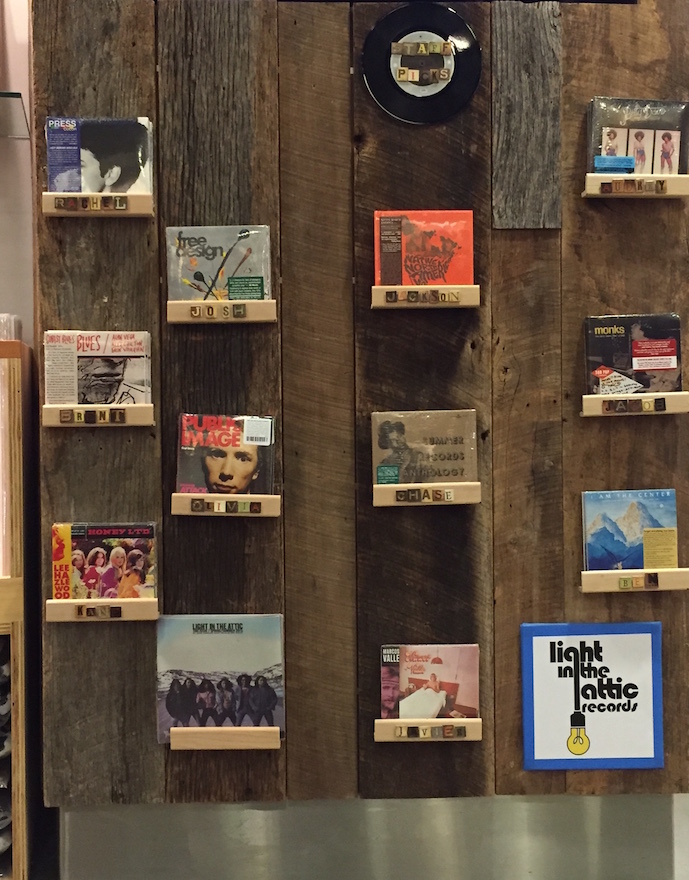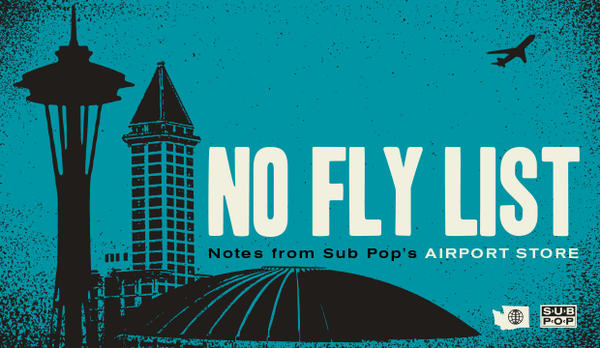NEWS : TUE, FEB 16, 2016 at 10:10 AM
No Fly List: Notes from Sub Pop’s Airport Store (February 2016)
Light in the Attic, I Choose You!
The Staff of the Sub Pop Airport Store Pick Their Favorite Light in the Attic Releases
Beginning this month, the Sub Pop Airport Store has unveiled its newest addition: a staff picks section! On a semi-regular basis, we, the illustrious and expert curatorial airport store staff, will be highlighting and showcasing different albums that we really, really, really, like. For our inaugural staff picks, we decided to all choose albums from Light in the Attic, a Seattle record label that specializes in re-issuing criminally under-appreciated music. In honor of this being our first round of staff picks, I asked my fellow co-workers, “Why did you pick the album that you picked?” Here’s what they said…
(Be sure to check out the Spotify playlist down below, which contains our favorite tracks from these albums.)
Betty Davis: Betty Davis
Audrey says: “Betty Davis is a psychedelic funk queen who pushed boundaries and broke stereotypes in the name of self expression. With the encouragement of T-Rex singer Marc Bolan, she switched from writing songs for others to songwriting for herself. This self titled album released in 1973 is the first of three albums that are so freaky and badass, religious groups protested her shows and radio stations banned some of her songs. She was really a musician ahead of her time.”
Lizzy Mercier Descloux: Press Color
Rachel says: “I first found Lizzy Mercier Descloux’s Press Color in a rare record store super score! Someone had sold a bunch of their no wave/Ze Records titles like Contortions, Mars, and Teenage Jesus and the Jerks. Press Color was one of my favorites because it’s so fun and danceable. Thanks to Light In The Attic Records for reissuing this great record!”
The Free Design: Stars/Time/Bubbles/Love
Josh says: “Funk-filled, family friendly, kite flying, wholesome harmonies, only god itself could have reissued as heavenly a record. But since god is not real, it must be the goodly folks at Light in the Attic and to them I give thanks and praise.”
Monks: The Early Years 1964-1965
Jacob says: The Monks’ 1966 one-off album Black Monk Time is an out of time, anti-Vietnam war, proto-art-rock oddity, made by some forward thinking discharged American GI’s stationed in Germany (playing and honing their skills at some of the same wild nightclubs the Beatles had made a name for themselves in a few years prior), that while probably not being directly influential, at the very least predicted, and works as a critical jump-off point for a lineage of still to come conceptual agitating greats like Devo and the Residents. I would consider the album an artistic equal to Zappa’s Freak Out!, also from 1966, and a distant relative to more recently recognized, and ahead of their time, Los Saicos, from Peru.
This brings me to my Light In The Attic showcase selection: Monks’ The Early Years.
At first, a listener familiar with Black Monk Time may be slightly disappointed with these demos lack of finished lyrics, or all out vocal assaults found on the album proper. But that is actually part of the strength and distinction that makes the demos these GI’s made so very interesting; the sheer chunky rhythmic monotony and minimalist organ-preset style jungle-tom drumming, and what I see as the secret ingredient to their sound: the snare drum doubled up by nearly-indiscernible, textural muted banjo strikes. All of this is to the forefront on these demos. The Stooges had their single repetitive piano note through a song, and the Monks had their transparent banjo, damn it! To put this all in context, the Monks pre-date the full swing of Jazz Rock Fusion, and Progressive rock drumming; it would be another 6-7 years until Krautrock bands learned to unlearn and play-on-purpose the simplified, minimal, ‘Motorik’ beat. I sincerely wonder if whoever it was who approached CAN’s Jaki Leibezeit and profoundly stated “you must play monotonous” had been lucky enough to have seen the Monks do it first.”
Honey Ltd: The Complete LHI Recordings
Kane says: “Good harmonies.”

Public Image Ltd: First Issue
Olivia says: “PiL broke the punk paradigm with this first album. Punk was now carte blanche, not just a sped up tempo with a fashion shtick. I can’t listen to this without thinking about how Seattle was channeling punk on its own terms years later. I think we were really inspired by this post-punk freedom! Punk rock should ALWAYS be about freedom. That includes being free to call out any particular icon, steal their booze and comfy chair, and throw salami on their bus if necessary…”
Marcos Valle: Marcos Valle
Javier says: “I just really like the flavors presented here. Thumpy, warm melodic bass lines, very chill vocals, mostly in Portuguese, tasteful touches of piano chords and the drumming is just straight up groovy. I have no idea what these songs are about but there are some really delightful flute bits and psychedelic touches sprinkled throughout. Just a solid little nugget of good Bossa Nova made in 1970. Sign me up!”
Various Artists: I Am The Center: Private Issue New Age In America, 1950-1990
Ben says: “Trading in the ‘sex, drugs and rock ‘n roll’ for crystals, eastern philosophies and incense (and well, ok, maybe not trading away all of the drugs…) New Age wasn’t about fame and fortune. Instead, it explored the boundaries of music: From Gregorian chants to gongs, and from chimes and bells to synths. I Am The Center covers 40 years of New Age, focusing mostly on home-made recordings and unheralded-in-their-own-time artists. (While also leaving out soft heavy hitters like Yawni and Enya (a.k.a, the soundtrack to my childhood road-trips)). Let these CDs help you open your third eye, align your chakras, or even relax while paying your taxes (if possible).”
Various Artists: Native North America (Vol. 1): Aboriginal Folk, Rock, and Country 1966–1985
I say: “Vancouver-based record archaeologist Kevin “Sipreano” Howes spent 15 years searching for music from the Indigenous peoples of Canada and the northern United States, and Native North America is the culmination of his efforts. Taking cues from the genres of “folk, rock, and country” that ruled over popular music in the latter half of the 20th century, you will hear Arctic garage rock from the Nunavik region of northern Quebec, melancholy Yup’ik folk from Alaska, and hushed country blues from the Wagmatcook First Nation reserve in Nova Scotia, among many other sounds and locales. Listening to this staggering compilation reminds me of the work that Bruce Pavitt did with the original Sub Pop fanzines, scouring for artists outside of the major cultural hubs of North America, and discovering vibrant, enriching, and totally unique regional music.”
Various Artists: Summer Records Anthology (1974-1988)
Chase says: “Summer Sound Studios was a Toronto-based record label started by Jerry Brown that produced some of the first notable Canadian reggae artists. This compilations covers releases from ‘74-‘88 and includes alternate masters and some previously unheard takes, all of which are really great! Stand out tracks include, “Right, Right Time,” “Warrior,” and “Dreadlock Lady”. A must buy if you’re trying to warm up this winter.”
Alan Vega, Alex Chilton, Ben Vaughn: Cubist Blues
Brent says: “Coming from a vinyl completest of all things Big Star and Suicide, it took a LITA reissue to finally bring “Cubist Blues” to my ear holes. Not to mention It was only pressed once in Spain twenty years ago and would set you back at least a hundred bucks. I discovered Alex’s Chilton’s output from the 1980’s and began to avoid it for the most part. I admire the company he kept and his taste for self-destruction: if you haven’t seen the footage of his performance with the Panther Burns live on the Marge Thrasher show, do so now: https://youtu.be/2U-k32L0KCc
I can’t help but think of one of Gene Vincent’s last albums, I’m Back and I’m Proud, when listening to “Cubist Blues”, which was produced by Kim Fowley, who also collaborated with Ben Vaughn. I want to think of this as a ‘art rock’ record, but that might just be the fact that Vega is a sculptor and Chilton’s parents owned a gallery. This is my pick of this month mostly because I usually only want to listen to Suicide, and so I figured I’d see what happened.”
